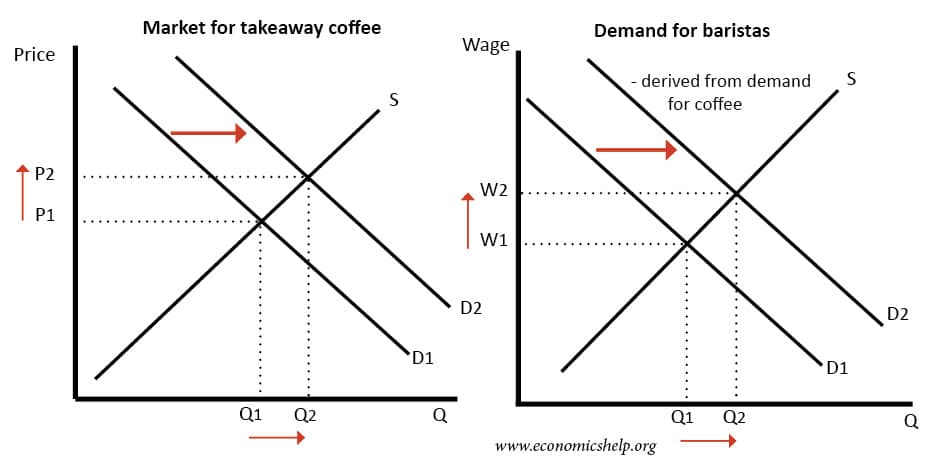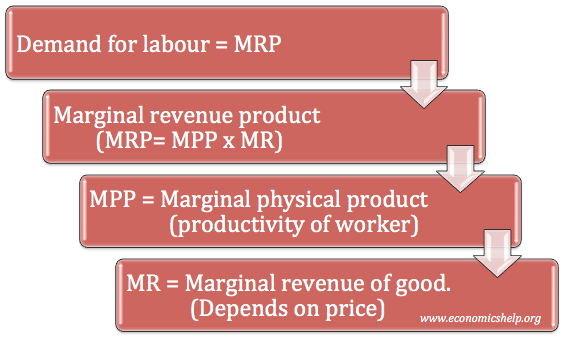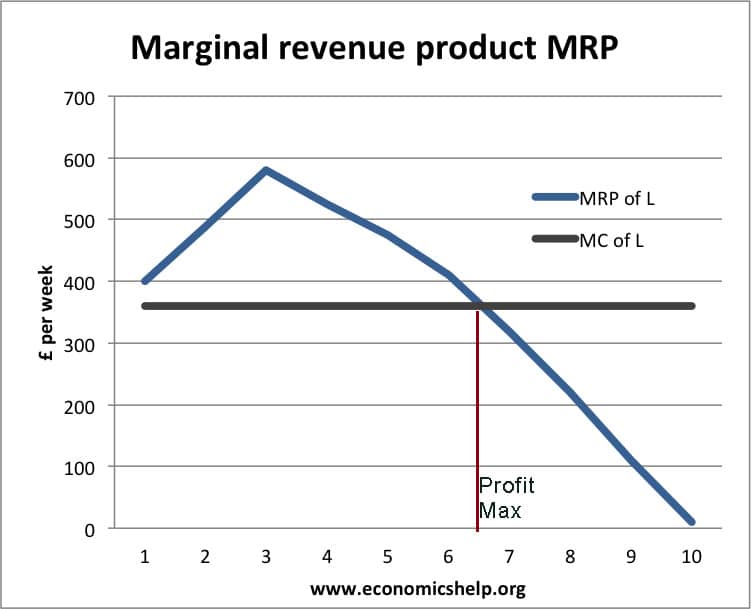Demand for labour is a derived demand. This means it depends on demand for the product the worker is producing.
- If there is an increase in demand for visiting coffee shops, it will lead to an increase in demand for baristas (people who make coffee)
- The demand for labour will also depend on labour productivity, the price of the good and their overall profitability to a firm.
Derived demand
This shows how the demand for baristas depends on demand for takeaway coffee.
Marginal Revenue Product of Labour (MRP)
This is an economic theory which suggests demand for labour depends on the marginal revenue product of a worker.
MRP = MPP x MR
Definition of MRP
This is the extra revenue a firm gains from employing an extra worker. It depends on a workers productivity (PPP) and the Marginal Revenue (MR) of the last good sold.
Definition of Marginal Physical Product (MPP)
This is the extra output that an extra worker produces.
- Due to the law of diminishing returns, in the short run, there is usually a diminishing marginal product when increasing the number of workers.
Marginal Revenue (MR)
This is the revenue that a firm gains from selling the last unit of output. It is closely related to the price of the good sold, and hence the demand for the good. If a good increases in demand, it pushes up the price and therefore, the firm will be willing to pay more to employ labour.
Therefore the demand for labour depends upon
- The productivity of labour (MPP)
- The demand for the good – which determines the price and marginal revenue of last good sold.
- The wage rate, strictly this is the MC of labour.
Example
This shows the MPP and MRP of labour.
After 3 workers, employing more workers causes a fall in the marginal productivity – a classic example of diminishing returns.
In this case, the marginal cost of labour is constant – £360 a week.
This gives us a graph showing MRP of labour and Marginal cost of labour.
To maximise profits, the firm will employ at an equilibrium where marginal revenue of an extra worker equals the marginal cost of employing an extra worker.
As you can’t employ six and a half workers, the firm will have to employ either six or seven!
Wage determination in competitive labour markets
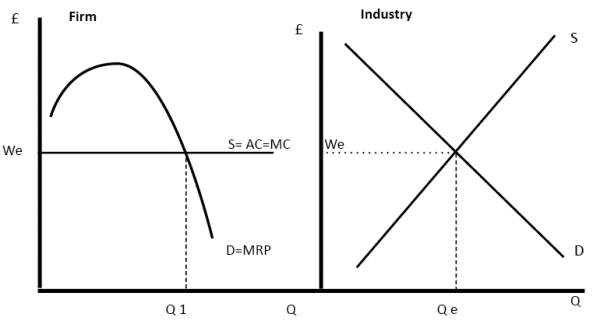
- The industry wage is determined by supply and demand for labour.
- An individual firm in a perfectly competitive labour market is a wage taker. Therefore, its supply curve is elastic.
- The firm maximises profits where MRP of workers equals the marginal cost of employing them (at Q1).
Examples of MRP of labour
If we take a premiership footballer, they have a high MRP. If they score winning goals, they can earn substantial revenue for their club (in prize money, tv rights). Therefore, if one player can make the difference of staying in Premier League, they may be worth £20m a year. Because there is a lot of money in football, the top players can demand high wages.
By comparison, if we take a retail assistant in a clothes shop, the value of clothes they sell per week will be relatively low. Therefore, their addition to profit will be relatively small, and this is a factor behind the much lower wage rates.
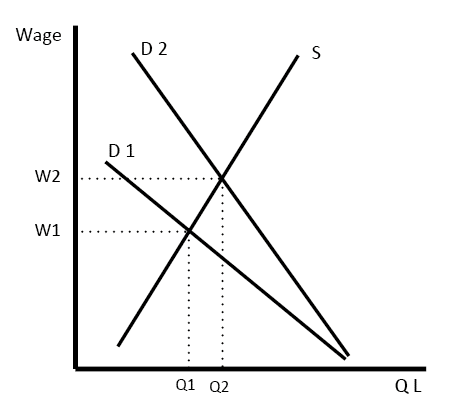
D2 = higher MRP – this leads to higher wage of W2
D1 = lower MRP – this leads to a lower wage of W1.
Marginal revenue product in the real world.
In the real world demand for labour is more complicated and there are more factors than MRP
- Difficulties of measuring. For many jobs, it is difficult to measure a worker’s productivity. If you pick strawberries, it is relatively easy to measure. But, if you teach or work in the civil service, it is very difficult as there is no physical output to count. Therefore, firms have to make best guesses about productivity and value of a worker.
- Public sector wages. Many public sector jobs are not determined by market forces but government policies and attitudes to employment. It depends on a normative judgement of what we consider a job is worth.
- Efficiency wage theory. This theory states that paying a higher wage can contribute to increasing worker’s productivity and morale. Cutting wages will depress productivity.
- Comparison. In the real world, workers pay much attention to relative pay gaps – do they get more than a junior colleague? Are pay differentials maintained?
- Non-monetary benefits of jobs. A firm may feel that if a job is highly prestigious or desirable, they can pay a lower wage and still get people to work. For example, jobs like nursing or teaching may be filled by people looking for job satisfaction rather than maximising profit.
- Discrimination. Employers are not necessarily rational but may pay lower wages to particular groups of workers.
- Wage contracts. Firms may offer wage contracts for a year or more. If there is seasonal demand for their good, they don’t put up wages in response to this.
- Reciprocity and good will. Many labour markets depend on good-will and concepts of reciprocity. For example, an employer may rely on a worker’s goodwill to do unpaid overtime, if a cafe is exceptionally busy. Always paying bonuses or trying to figure out a workers MRP can undermine this process of reciprocity. These ideas are more common in behavioural economics than this neo-classical model.
Related pages

